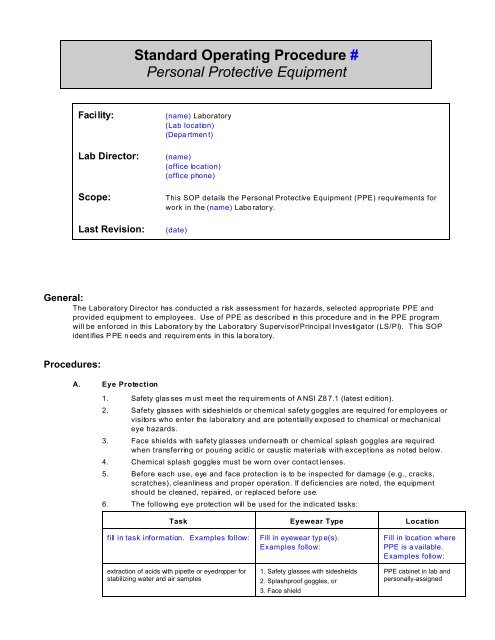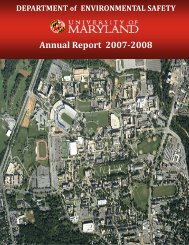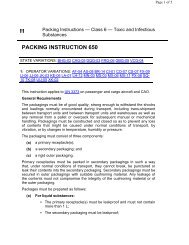Standard Operating Procedure # Personal Protective Equipment
Standard Operating Procedure # Personal Protective Equipment
Standard Operating Procedure # Personal Protective Equipment
You also want an ePaper? Increase the reach of your titles
YUMPU automatically turns print PDFs into web optimized ePapers that Google loves.
<strong>Standard</strong> <strong>Operating</strong> <strong>Procedure</strong> #<strong>Personal</strong> <strong>Protective</strong> <strong>Equipment</strong>Facility:Lab Director:Scope:Last Revision:(name) Laboratory(Lab location)(Departmen t)(name)(office location)(office phone)This SOP details the <strong>Personal</strong> <strong>Protective</strong> <strong>Equipment</strong> (PPE) requirements forwork in the (name) Labo ratory.(date)General:The Laboratory Director has conducted a risk assessment for hazards, selected appropriate PPE andprovided equipment to employees. Use of PPE as described in this procedure and in the PPE programwill be enforced in this Laboratory by the Laboratory Supervisor/Principal Investigator (LS/PI). This SOPidentifies P PE n eeds and requ irem ents in this la bora tory.<strong>Procedure</strong>s:A. Eye Protection1. Safety glas ses m ust meet the req uirements of A NSI Z8 7.1 (latest edition).2. Safety glasses with sideshields or chemical safety goggles are required for employees orvisitors who enter the laboratory and are potentially exposed to chemical or mechanicaleye hazards.3. Face shields with safety glasses underneath or chemical splash goggles are requiredwhen transferring or pouring acidic or caustic materials with exceptions as noted below.4. Chemical splash goggles must be worn over contact lenses.5. Before each use, eye and face protection is to be inspected for damage (e.g., cracks,scratches), cleanliness and proper operation. If deficiencies are noted, the equipmentshould be cleaned, repaired, or replaced before use.6. The following eye protection will be used for the indicated tasks:Task Eyewear Type Locationfill in task information. Examples follow:extraction of acids with pipette or eyedropper forstabilizing water and air samplesFill in eyewear type(s).Examples follow:1. Safety glasses with sideshields2. Splashproof goggles, or3. Face shieldFill in location wherePPE is a vailable.Examples follow:PPE cabinet in lab andpersonally-assigned
PPE SOP #Page 2dispensing acids to portable containersany other chemical-handling in labentry into other labs for consultations,discussions, etc.Response to incidental hazardous materials spills1. Splashproof goggles, or2. Safety glasses with sideshields andfull face shield1. Safety glasses with sideshields2. Splashproof goggles, or3. Face shield1. Safety glasses with sideshields, or2. Splashproof goggles1. Splashproof goggles, or2. Full-face respiratorPPE cabinet in lab andpersonally-assignedPPE cabinet in lab andpersonally-assignedPPE cabinet in lab andpersonally-assignedPPE cabinet in lab andpersonally-assignedB. Gloves1. Che mic al res istant glove s shall be w orn w henever the potential for hazardou s sk incontact exists. The material safety data sheet for the substance or glove selectioncharts should be consulted to determine appropriate glove type/material. Gloveselection reso urce s will be cons ulted when em ployee s are unsu re wh at type of glove isnecessary for protection against specific chemicals. DES maintains glove selectionand MSDS resourc es on its website at:http://www.des.umd.edu/os/ppe/glove/index.htm lhttp://www.des.umd.edu/os/rtk/m sds/inde x.html2. Lab-specific standard operating procedures specify glove requirements for identifiedroutine operations.3. Gloves shall be removed before touching other surfaces (e.g., doorknobs, faucethandles, keyboards).4. Heat resistant gloves shall be used for handling hot objects. Asbestos-containinggloves will not be used.5. Abrasion resistant gloves (such as leather) should be worn for handling broken glassor for other potentially abrasive situations. They should NOT be used for handlingchemicals. Gloves are not necessary if broken glass can be picked up with forceps,dustpan, etc.6. Before each use, gloves are to be inspected for dam age and contamination. Ifdeficiencies are noted, the gloves should be cleaned, repaired, or replaced before use.7. The following types of gloves will be used for the indicated tasks:Task Glove Type Locationfill in task information. Examples follow:Fill in glove type(s). Examplesfollow:Fill in location wherePPE is a vailable.Examples follow:acidification of water & air samplesentry into other labs for consultations,discussions, etc.Response to incidental hazardous materials spills1. Two-mil nitrile, or2. Neoprene, or3. VitonTwo-mil nitrilegloves compatible with spilled chemical(e.g., butyl, neoprene, Silvershield,Viton, natural rubber, nitrile, 4H, etc.)PPE cabinet in labPPE cabinet in labPPE cabinet in lab or asavailable in DESresponder’s bagasbestos or lead bulk sampling Two-mil nitrile PPE cabinet in lab
C. FootwearPPE SOP #Page 31. No sandals or open-toed shoes are to be worn by employees entering UM lab facilities.Shoes should have non skid soles and should have a reas onable heel height.2. Safety shoes m ust be worn if there is potential for injury from heavy obje cts (e.g.,handling drums, cylinders). The LS/PI is responsible for procuring safety shoes if theyare d eterm ined n ecessary.3. Safety shoes must meet the requirements of ANSI Z41 (latest issue).D. Clothing1. Laboratory coats or other suitable work apparel shall be worn by laboratory employeeswhenever there is potential for chemical exposure in the work area.2. Clothing must be cleaned regularly. If a spill occurs on the clothing, it must bedecontamin ated befo re reu se. Lab clo thing shou ld not be wa shed with other hou seholdclothing.3. Disposable clothing should be considered when working with highly toxic materials,carcinogens, mutagens, or teratogens. The LS/PI is responsible for determining theneed for disposable clothing.4. Before each use, clothing is to be inspected for damage, deterioration, contamination.If deficiencies are noted, the clothing should be cleaned, repaired, or replaced beforeuse.5. Shorts will n ot be worn in the la bora tory.6. The following types of protective clothing will be used for the indicated tasks:Task Type Locationfill in task information. Examples follow:asbestos or lead bulk samplingentry into other labs for consultations,discussions, etc.Response to incidental hazardous materials spillsFill in glove type(s). Examplesfollow:Tyvek disposable suit with attachedhood and shoe coveringslab coatClothing compatible with spilledmaterial and conditions of exposure.May include disposable Tyvek, polylinedTyvekFill in location wherePPE is a vailable.Examples follow:corner cabinet in labcoat hooks in labcorner cabinet in lab orESF dry storage areahandling any chemical materials in lab lab coat coat hooks in labE. Hearing Protection1. Hearing protection (earm uffs or plugs) is required whenever employees are exposed tonoise levels of 85 de cibels or greater as an 8-hour time w eighted average (TW A).Industrial Hygiene workers exposed to noise levels in excess of 90 dBA will wearhearing protection regardless of the duration.2. Hearing protection is to be inspected before ea ch use, for tears and contamina tion. Ifdeficiencies are noted, the hearing protector should be cleaned, repaired, or replacedbefore use.3. Annual audiogram and other requirements of the UM Hearing Conservation Programapply if full-shift no ise ex posures are 85 dec ibels o r grea ter. T he Program is ava ilableat:http://www.des.umd.edu/os/hearing/manual/inde x.html
4. The following types of hearing protection will be used for the indicated tasks:PPE SOP #Page 4Task Type Locationfill in task information. Examples follow:Fill in glove type(s). Examplesfollow:Fill in location wherePPE is a vailable.Examples follow:evacuation drills foam plugs or muffs PPE cabinet in lab or asavailable in DESresponder’s bagassessment of possible high noise areas foam plugs or muffs PPE cabinet in lab or asavailable in DESresponder’s bagF. Respirato rs1. Res pirato ry protection is no t requ ired fo r any ro utine work cond ucted in the labor atory.2. Industrial Hygiene staff that are responsible for assessing chemical spill sites mustensure that they and other DES responders have respirators capable of controlling theparticular chemical species and concentration. Emergency conditions (i.e., airbornecontam inants in ex cess of established Immed iately Dangerous to Life and H ealthconcentrations) are to be handled by Prince George’s County emergency responsepers onnel.3. All employees issued respirators for any reason must follow all the requirements setforth in the U M Respiratory Protection P rogram . The Program is available at:http://www.des.umd.edu/os/respirator/manual/inde x.html4. The following types of respiratory protection will be used for the indicated tasks:Task Type Locationfill in task information. Examples follow:Fill in glove type(s). Examplesfollow:Fill in location wherePPE is a vailable.Examples follow:obtaining bulk asbestos or lead samplesentering (asbestos) restricted areas oroverseeing asbestos abatement activities incontainmentincident responsehalf-face air-purifying respirator withP100 filters, orfull-face air-purifying respirator withP100 filters, orfull-face powered air-purifyingrespirator with P100 filtersfull-face powered air-purifyingrespirator with P100 filtersfull-face air-purifying respirator withcartridges selected for specificcontaminant, orfull-face powered air-purifyingrespirator with cartridges selected forspecific contaminantrespirators are individuallyfitted and assigned.Additional filters areavailable on shelves in thelab.respirators are individuallyfitted and assigned.Additional filters areavailable on shelves in thelab.respirators are individuallyfitted and assigned.Additional filters areavailable on shelves in thelab.
PPE SOP #Page 5mold assessmentN/R/P95, N/R/P99, or N/R/P100disposable facepiece respirator, orhalf-face air-purifying respirator withP100 filters, orfull-face air-purifying respirator withP100 filters, orfull-face powered air-purifyingrespirator with P100 filtersrespirators are individuallyfitted and assigned.Additional filters areavailable on shelves in thelab.5. Specific information concerning respirator capabilities, filter selection, IDLHconcentrations, etc., is contained in the DES Respiratory Protection Programmaintained by the IH Equipm ent Lab director.Training:1. Em ployee s using PPE m ust be train ed in p rope r sele ction, care and u se. T he LS /PI isrespon sible for pro viding training for protec tive eyewea r, footwea r, gloves and clothing .2. Users of respirators other than filtering facepiece models must be trained annually by theDepartmen t of Environ men tal Safety.3. Users of hearing protection who are exposed to full-shift average noise levels over 85 dBAmu st be traine d ann ually by th e De partm ent of Env ironm ental Safe ty.4. The LS/PI is responsible for ensuring that respiratory protection and hearing conservationtraining are provided when employees have a demonstrated need for entry into theseprograms.
















